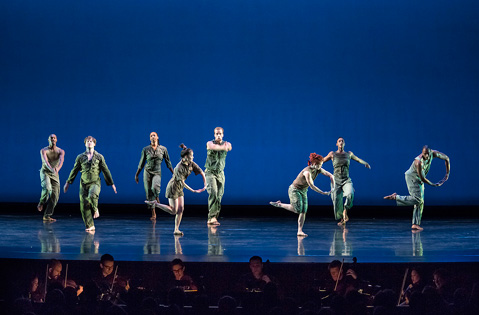Review: Bill T. Jones/Arnie Zane Dance Company at the Granada Theatre
Luminary Modern Dance Group Performed at the on Wednesday, October 16

When children swing on the monkey bars, we call it “play.” When a pianist makes music, we use the same word. And when Bill T. Jones stages a dance, it’s a highly refined form of the very same thing.
On Wednesday night at the Granada, UCSB Arts & Lectures presented the Bill T. Jones/Arnie Zane Dance Company in Play and Play, an evening of dance set to live music. Across three works spanning from 1977 to 2000, two qualities remained consistent: a playful spirit, and a sense of freshness.
The program opened with the newest work, “Spent Days Out Yonder,” set to the sprightly andante movement of a Mozart string quartet. Accompanied by the Los Angeles-based Calder Quartet, dancers in flowing pants moved across the stage in loose processions, alternating between suggestions of laxness (wobbly knees, flopping arms) and moments of sublime, controlled fluidity. In the arresting final passage, all nine dancers formed a tableau, shifting slowly off stage as the strings drew out one last, soaring note.
“Continuous Replay” began with a burst of strings and movement: stark naked, Erick Montes Chavero exploded onstage, leapt about wildly, and disappeared just as fast. Eventually, he reemerged and began a series of minimal gestures: a turn of the head, the lifting of a fist, a wide-armed lunge. Over time, the structure of dance emerged — a steady accumulation of gestures, dancers, costumes, and sounds. In its original incarnation as “Hand Dance,” this was a solo for Zane, who was fascinated by the minimalist dance experiments of the early 1970s. In its current manifestation, it’s a masterpiece of theme and variation.
Set to a Mendelssohn octet, “D-Man in the Waters” is the most exuberant, celebratory work on this program, and a showcase for the company’s remarkable athleticism. Dedicated to the memory of a company dancer who battled AIDS, the work is a rousing affirmation of the power of community. Army fatigues suggest a battle, but the dancers belie that theme as they spring joyously into each other’s arms and join in happy communal gestures, including a tummy slide across the stage. Despite its darker passages — or maybe because of them — it’s in “D-Man” that the “play” reaches its pinnacle. How else can one respond to death, Jones seems to be asking, than with life, in all its ecstasy?



